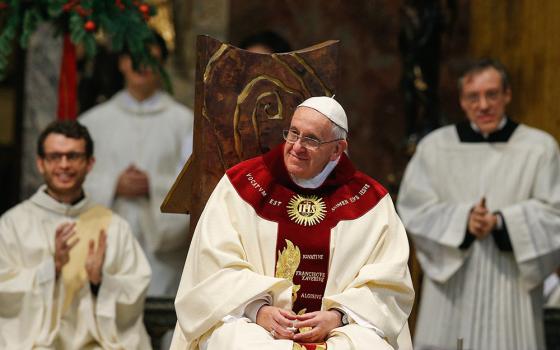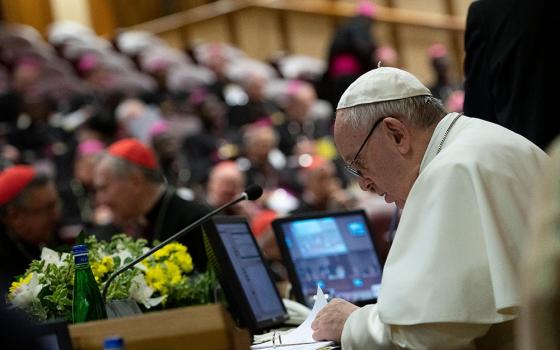The reforms of the Roman Curia being discussed are tectonic. Better to say, the discussion is tectonic. Re-arranging several Pontifical Councils into a super-dicastry is not earth-shattering, although the decision to erect a new office on environmental issues as a part of the new dicastry on Justice, Peace & Charity demonstrates an institutional commitment to the issue, in addition to the magisterial commitment we anticipate later this year. That is important. But, what is really important is the manner in which these reform proposals have come to be.
We know that Pope Francis was elected by his brother cardinals in part because they believed he was capable of affecting these kinds of reforms. Within a month of his election, he formed the C-8, now C-9, group of cardinals, drawn from around the world, to advise him on these reforms. The cardinals were not drawn from the Roman Curia, but from the different continents. They had been on the receiving end of curial dysfunction. Now, the reforms are being discussed by the full College of Cardinals. Pope Francis, before our eyes, is bringing the imperial papacy to an end and introducing a new approach to governance of the universal Church, and it is that new approach to governance that is a tectonic shift.
In the 1950s, Fr. John Courtney Murray, S.J. had a dinner in Rome with Cardinal Stritch. In the course of the meal, Murray was encouraging Stritch to push back against the Holy Office on the issue of religious liberty and Murray cited Cardinal Gibbons' efforts fifty years earlier. Stritch replied, “Well, none of us can go as far as Gibbons went.” In a letter to his friend Msgr. John Tracy Ellis, Murray said he wanted to jump out of his chair and say, “Why not?” Of course, he knew the answer. During the pontificate of Pope Pius XII, the papacy reached its apotheosis. The Raj was gone. Austria was a republic. Versailles was a museum. But, the pope was carried on a throne, with ostrich plumes on either sides, and aides were instructed to expect a call from the pope so that they could be kneeling when they picked up the receiver. Not even the cardinal-archbishop of Chicago was going to object to anything that came from the Roman curia.
Ultramontanism, as an effective form of governance as opposed to an idea, came about largely because it could: With the advent of the telegraph and then the telephone, papal pronouncements were now published in the newspapers the next day. No longer were encyclicals still really letters, sent to the world’s bishops, which those bishops would translate and disseminate, adding their own emphasis in presenting it to their clergy, who, in turn, further refined the teaching when presenting it to the people in the pews. Nominations for new bishops were no longer in the hands of local clergy, or local governments, but in the hands of papal nuncios, branch managers for the curia. The centralization of authority that occurred in the past 150 years was unimaginable beforehand for very prosaic reasons.
The idea of ultramontanism grew from a different set of experiences, the continued prostration and occasional persecution of the Church by the secular authorities. Their Most Christian Majesties, the Kings of France, had jealously guarded the prerogatives of the Gallican Church and refused to implement the decrees of the Council of Trent for decades. The Bourbon monarchs of Spain and France forced the Pope to suppress the Jesuits in 1773, a low point in papal authority to be sure. The Holy Roman Emperor, Joseph II, took an interest in Church affairs – Frederick the Great of Prussia called him, “my cousin, the sacristan” –and the Church in Hapsburg lands took its cues from Vienna, not Rome, and Joseph even coerced Pope Pius VI into coming to Vienna to negotiate their differences, rather than go to Rome himself as a Christian pilgrim. The French Revolution perpetrated horrors against the Church and Bonaparte arrested two popes in a row. The Risorgimento took the last of the Papal States and Pope Pius IX proclaimed himself a “prisoner of the Vatican.” It is no coincidence that in the face of this tide of ruin, indeed at its culmination with the seizure of Rome itself by Garibaldi, that the First Vatican Council proclaimed the doctrine of papal infallibility. Even in my own lifetime, Pope Paul VI continued to use the royal “we” when giving a speech. The Church might have lost its power without, but the papacy would increase its power within.
The 1782 visit of Pope Pius VI to Vienna did more than highlight the relative impotence of the papacy in the face of secular power. Along the long route, through various Italian states, across the Alps and into Austria, the simple people lined the roads, seeking the pontiff’s blessing. The humiliations and sufferings of Pius VII at the hands of Napoleon made this pope a hero, too, to Catholic peasants who had not experienced much in the way of genuine liberation from the Revolution. By the last half of the nineteenth century, it was not uncommon for Catholic homes throughout the world to have a picture of beloved Pio Nono, the prisoner of the Vatican, in their home. This popular devotion to the Roman pontiff, combined, ironically, with the separation of Church and State brought on by the rise of liberalism (and fought by the Church), for the first time since Constantine gave the popes true freedom within the Church to govern it as they wished. This freedom was not absolute: After World War II, the French government negotiated the forced retirement of the worst collaborationist bishops during the Vichy years. But, ultramontanism became the default reality of Church governance.
The Second Vatican Council was, of course, a different kettle of fish, an exercise in collegial decision-making on the largest, and most significant, scale. The post-conciliar synods, designed to carry on that collegiality, never really blossomed. By the 1980s, they had become stale and unproductive. The sense that bishops who attended Vatican II had, that the universal governance of the Church was in their hands too, this became lost. Pope Francis is trying to bring it back.
Blessed Pope Paul VI, Saint Pope John Paul II and Pope Benedict XVI were all of them, in different ways, devoted to the Council, especially to its doctrinal formulations which retain a richness and a complexity that have still not been fully plumbed. But, the structure of the Council as an exercise in collegial decision-making, this came to a crashing halt. And, the episcopates created in the past thirty-five years were hardly chomping at the bit to re-introduce collegiality, especially in the U.S. where a defensiveness towards the ambient culture combined with an unwillingness to challenge the clerical subculture to produce a quiescent body. If Cardinal Stritch had thought he could not go as far as Gibbons, many of our current bishops wonder why anyone would want to go as far as Gibbons.
There are exceptions to this rule, to be sure, bishops who are embracing Pope Francis’ reforms. Just last night, Cardinal Donald Wuerl offered the most blunt and courageous defense of Pope Francis we have seen from an American prelate so far, and a clear challenge to those who oppose the pope. Additionally, +Wuerl is not simply bringing back an earlier variant of ultramontanism: He is in Rome to be consulted on the reforms at this moment, he was at the synod on the family last autumn and, by all reports, was critical in facilitating agreement and consensus. It is not just that he agrees with the pope on this point or that, so much as that he is embracing the process, the discernment, and the attentiveness to the Holy Spirit’s actions here and now that, previously, did not exist.
What is going on in Rome will not satisfy some whose activist personalities incline them to want the pope to conform to their agenda on all points. What is going on in Rome will not satisfy ideologues of left or right who are allergic to the kind of consensus building a synodal process requires and that today’s meeting of the full College of Cardinals evidences. But, what is going on in Rome right now holds the promise for the kind of deep reform the Second Vatican Council envisaged, in which the Church, starting with the pope, is willing to engage the world, not as a pedant but as a fellow pilgrim, to learn as well as to lecture, to accompany the people of God and not merely to assign them their tasks and duties. This kind of change does not, per se, mean that a particular reform, say, permitting the divorced and remarried to receive communion is more or less likely. Reforms must still be built upon an adequate theological basis. But, this kind of reform does mean that decisions will no longer be based solely on who has whose ear in the hallways of the Vatican. And that is a wonderful thing and an enormous thing. Don’t let the naysayers tell you otherwise.




